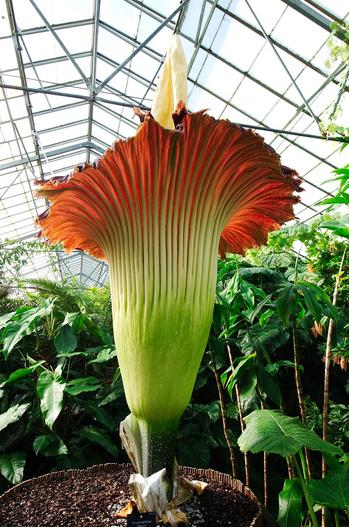Titan Arum
(Amorphophallus titanum)
Titan Arum (Amorphophallus titanum)
/
/

Magnus Hagdorn
CC BY-SA 2.0
Image By:
Magnus Hagdorn
Recorded By:
Copyright:
CC BY-SA 2.0
Copyright Notice:
Photo by: Magnus Hagdorn | License Type: CC BY-SA 2.0 | License URL: https://creativecommons.org/licenses/by-sa/2.0/ | Uploader: marsupium photography | Publisher: Flickr






















Estimated Native Range
Summary
Amorphophallus titanum, commonly known as Titan Arum, is a deciduous perennial herb native to the rainforests of western Sumatra, where it thrives in the warm and humid understory. It is renowned for producing the largest unbranched inflorescence in the world, which emits an odor reminiscent of a rotting corpse, earning it the nickname of carrion flower. The inflorescence can exceed 3 meters (10 feet) in height and features a spadix of flowers surrounded by a spathe that resembles a large petal. The spadix generates heat, which helps disseminate the odor and mimics the heat of decaying organic matter, thus attracting pollinators such as carrion-eating beetles and flesh flies. The Titan Arum’s blooming event is a spectacle, with the female flowers maturing before the male flowers to prevent self-pollination. Following the bloom, a leaf that can grow to the size of a small tree emerges from the underground corm.
The Titan Arum is a botanical marvel, sought after by botanical gardens and collectors for its extraordinary flowering event. Despite its challenging cultivation requirements, including high humidity, consistent warmth, and patience due to its infrequent blooming cycle, it is a prized specimen for its dramatic display. It is typically grown under glass in botanical gardens to replicate its native humid conditions. In cultivation, it requires well-drained soil rich in organic matter and part shade to mimic the dappled light of its rainforest home. Due to its size and the difficulty in replicating its native habitat, it is not commonly found in private collections.CC BY-SA 4.0
The Titan Arum is a botanical marvel, sought after by botanical gardens and collectors for its extraordinary flowering event. Despite its challenging cultivation requirements, including high humidity, consistent warmth, and patience due to its infrequent blooming cycle, it is a prized specimen for its dramatic display. It is typically grown under glass in botanical gardens to replicate its native humid conditions. In cultivation, it requires well-drained soil rich in organic matter and part shade to mimic the dappled light of its rainforest home. Due to its size and the difficulty in replicating its native habitat, it is not commonly found in private collections.CC BY-SA 4.0
Plant Description
- Plant Type: Herb
- Height: 5-10 feet
- Width: 7-9 feet
- Growth Rate: Moderate
- Flower Color: Red, Yellow, Purple
- Flowering Season: Spring, Summer
- Leaf Retention: Deciduous
Growth Requirements
- Sun: Part Shade
- Water: Medium
- Drainage: Medium
Common Uses
Showy Flowers
Natural Habitat
Rainforests of western Sumatra
Other Names
Common Names: Corpse Flower
Scientific Names: , Amorphophallus titanum, Conophallus titanum, Amorphophallus selebicus,
GBIF Accepted Name: Amorphophallus titanum (Becc.) Becc.